Some of the rarest types of lizards are white. From species that are mainly white to white morphs, there are still some species that can be seen today.
Various white specimens have also been created by those who breed lizards as pets.
The following species are among the mostly white lizards that live in the wilderness or that can be purchased as pet lizards.
1. Bearded Dragon – Zero Morph
White Bearded Dragons might be rare, but they are highly appreciated, especially by pet lizard owners.
These lizards come in all types of colors, including a rare white or almost completely white morph.
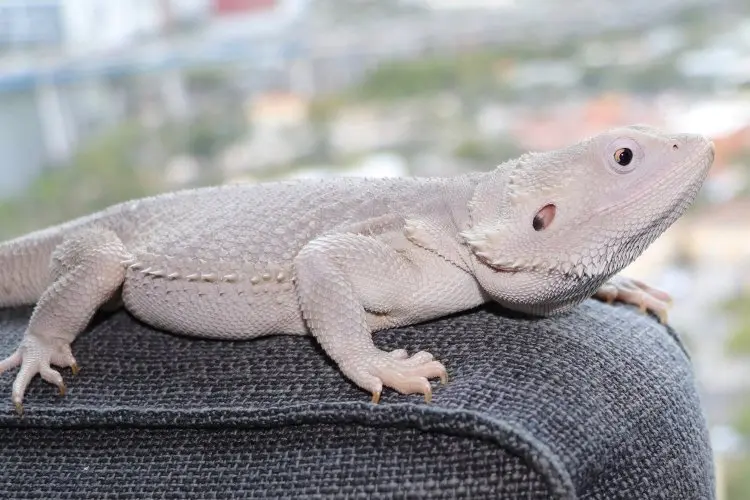
Bearded dragons can be white or off-white, depending on their region. They can be slightly off-white to gray when they live in cooler areas.
A species of Australian desert, Bearded Dragons has already spread through much of Australia.
This white morph has spread with the species and is most likely more common in captivity.
While white, this morph still represents Bearded Dragons as a species with its particularities.
It feats plants and flowers with additional insects making up their complete diet.
Like other Bearded Dragons, The Zero Morph Bearded Dragon is also very territorial and even aggressive.
Setting up the right enclosure avoids constant confrontation between lizards.
Together with other morphs or colors, The Bearded Dragon remains one of the most common lizards raised in captivity around the world.
2. Iguana – Snow Morph
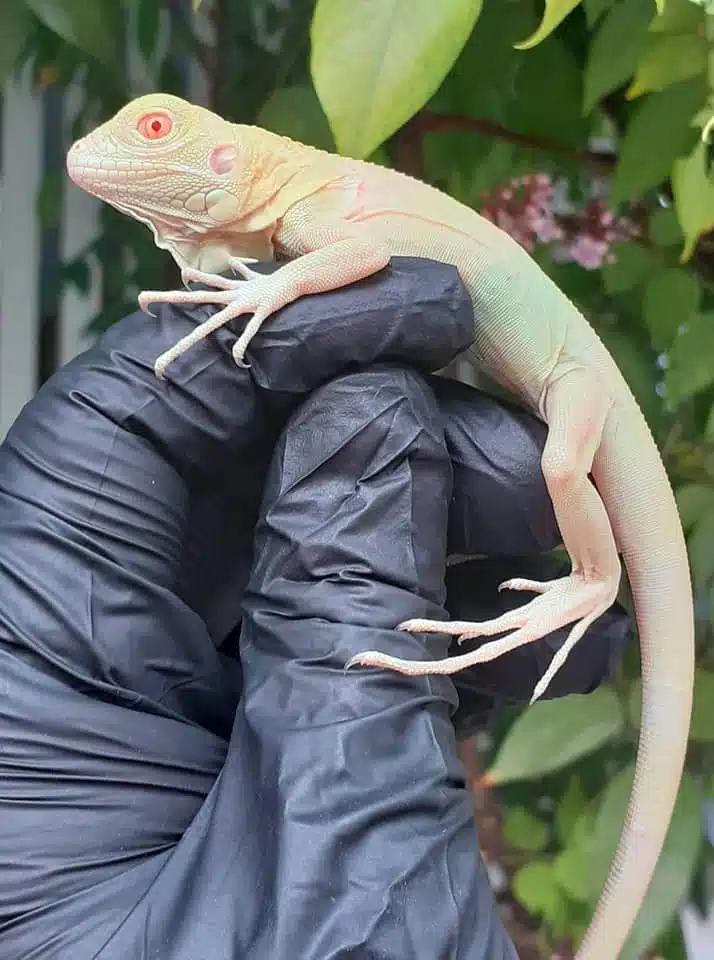
Iguanas come in different colors and are also highly common in captivity, as pet lizards.
Mostly known for their attractive green colors, Iguanas also come in different other colors, including a white morph.
What’s now known as Snow Moprh Iguana is the result of breeding blue iguanas with T-albino iguanas.
This is why the Snow Morph is mostly white with a few faint blue shadows across the dorsum.
Its white sections are often pure white or pearl white and inspire the name of this morph.
As Bearded Dragons, Iguanas are also highly territorial. These are the types of lizards that establish large territories for mating control.
Females establish multiple sites in a given area they protect. Males are also highly aggressive when it comes to breeding.
The number of partners is also high for mating iguanas. In general, these lizards prefer to mate more in the dry season.
Emerging iguanas in the wet season can have plenty of food as a result.
Bred in captivity, The Snow Morph is less susceptible to picking dry and wet season breeding partners.
3. Leopard Gecko – Blizzard Morph
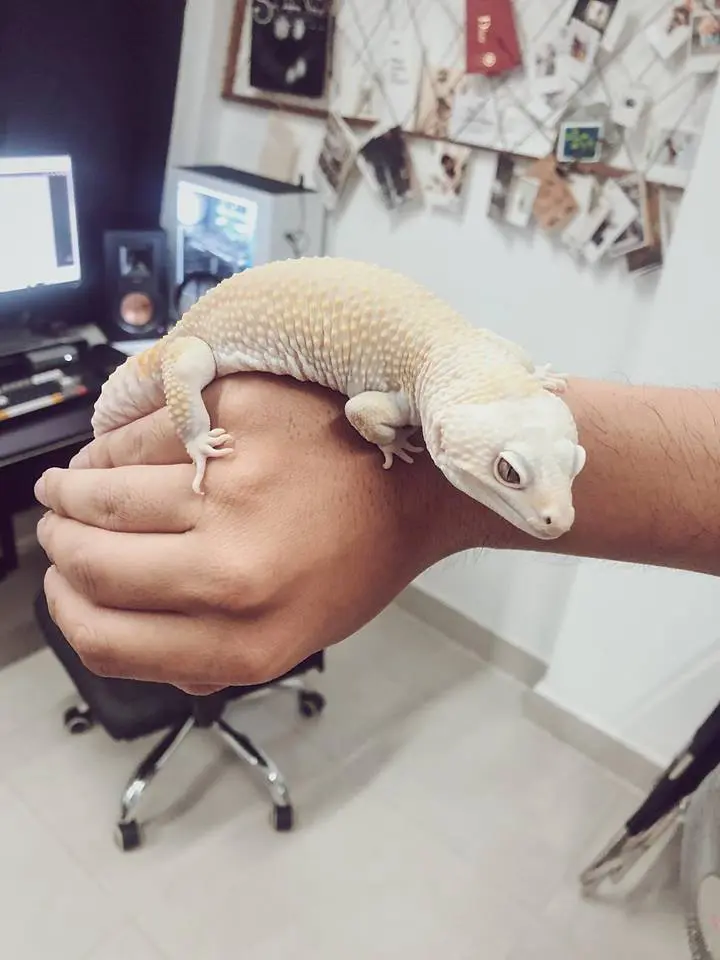
Blizzard morphs are pattern-free and exhibit white, yellow, or pink nuances.
In the case of Leopard Geckos, the ground color is mostly white, showing pink undertones. The Blizzard Morph may also show a faint yellow dorsal nuance.
Leopard Geckos are rarely white. These types of lizards are highly patterned and colorful.
Spots, bands, and blotches are all characteristic of these lizards. Even more, the Blizzard Morph is a rare sight in an all-white specimen which increases its value for captivity.
The lizards are also known for their wide tails. Sometimes appearing to be carrying a lump of fat, this is a tail adaptation for survival.
The species actually stores fat in its tail. This is used as an energy reserve for the days the gecko can’t find food.
Various bugs and insects are eaten by these geckos with additional types of food such as small mice, small tadpoles, and other vertebrates.
4. African Fat-Tailed Gecko – White Out Oreo Morph
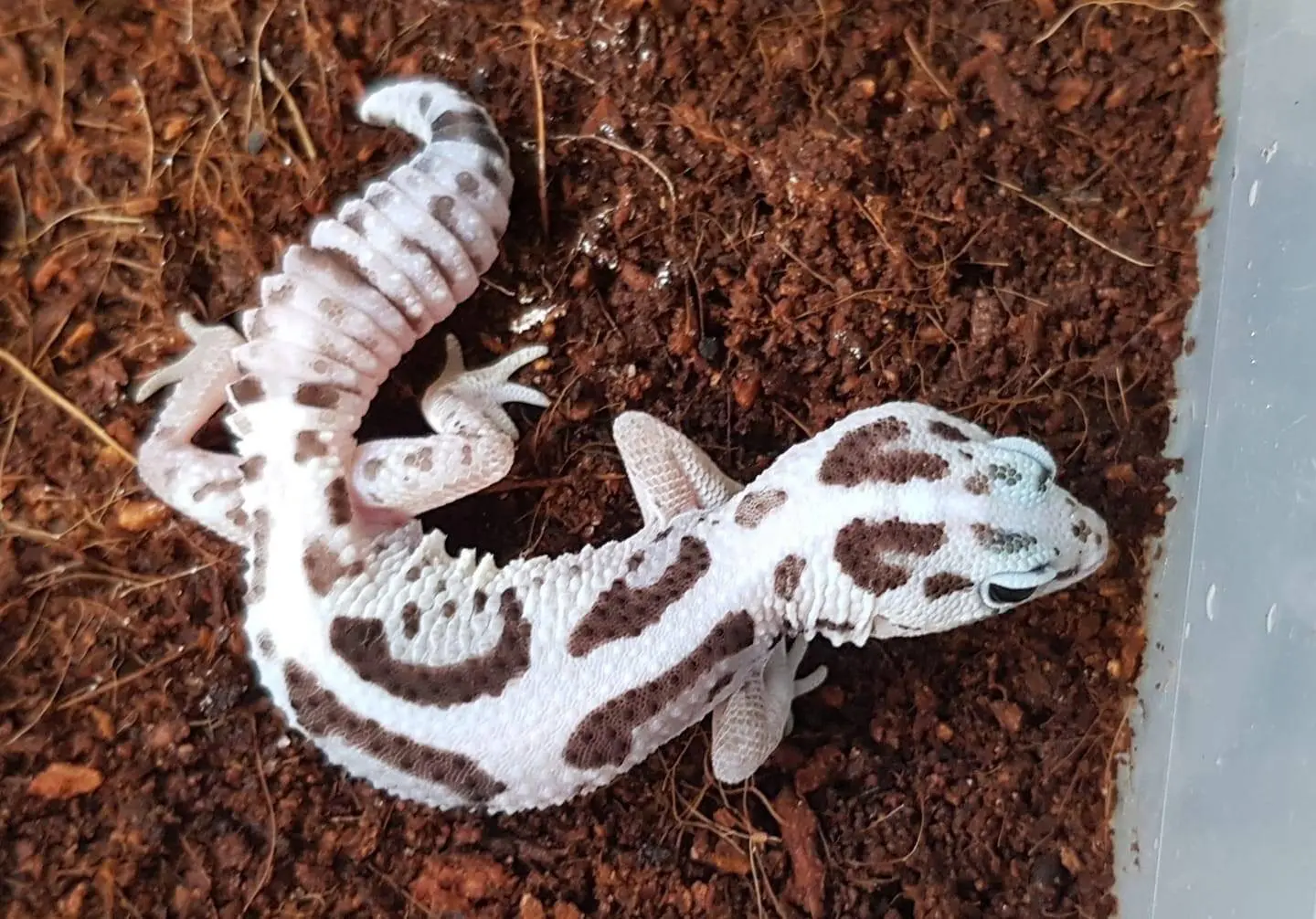
Mostly white, The African Fat Tailed Gecko of the White Out Oreo Morph is a rare sight. This species shows a mostly white base color with black patterns.
Some of its variants, especially for young geckos include a mostly white-pink version with black patterns.
This is a species native to Africa. The African Fat Tailed Gecko is normally endemic to West Africa, but its range is expanding in other dry areas of the continent.
While the gecko has an atypical white appearance, its name is inspired by the fat lump tail seen on these lizards.
This is not the case with most tails, but with regrown tails as The African, Fat Tailed Gecko has the capacity to lose its tail, survive, and grow another tail.
It undergoes this extreme measure to survive attacks, often first targeting the tail.
African Fat Tailed Geckos also use the wider lump-carrying tail that is regrown as an extra source of fat and energy.
5. Blue Tongue Skink – White Morph

There’s a white Blue Tongue Skink many pet lizard owners breed around the world.
A new species and a result of selective breeding, The White Morph Blue Tongue Skink is a species with a mostly white appearance which may sometimes come with faint bands such as tan lateral bands.
However, most times, the white specimen has uniform white dorsal and ventral coloring.
There’s no official name for the White Morph which may also be known as The Northern Morph or under different other nicknames.
While this species stands out immediately based on its jet-white appearance, it still maintains that rather rare blue tongue the species is known for.
Other variants of The Blue Tongue Skink include T+, a specimen that’s only partly white but which also comes with black and yellow bands and is not jet white as The White Moprh.
6. Crested Gecko – Lilly White
Lily Whites are a type of Crested Gecko Specimen only seen in captivity. This is a unique type of mostly white lizard.
You can purchase one for your tank or you can breed Lilly Whites yourself.
The main problem of the species is that it cannot be bred with other Lilly Whites as most offspring die.
It can only be bred with other Crested Geckos which produces unique offspring.
From offspring with a white crest, tail, and stripes, to mostly white lizards that show different colors and patterns depending on who they breed with, these types of lizards are of high aesthetic value in captivity.
Some of the brighter nuances mixed with Lilly White include white-cream, white-yellow, or white-orang specimens.
Highly attractive, Lily White specimens that are mostly white with a differently-colored head are also highly sought after.
Lily Whites are still growing in popularity as the species has only been creating around 10 years ago.
7. Bleached Earless Lizard
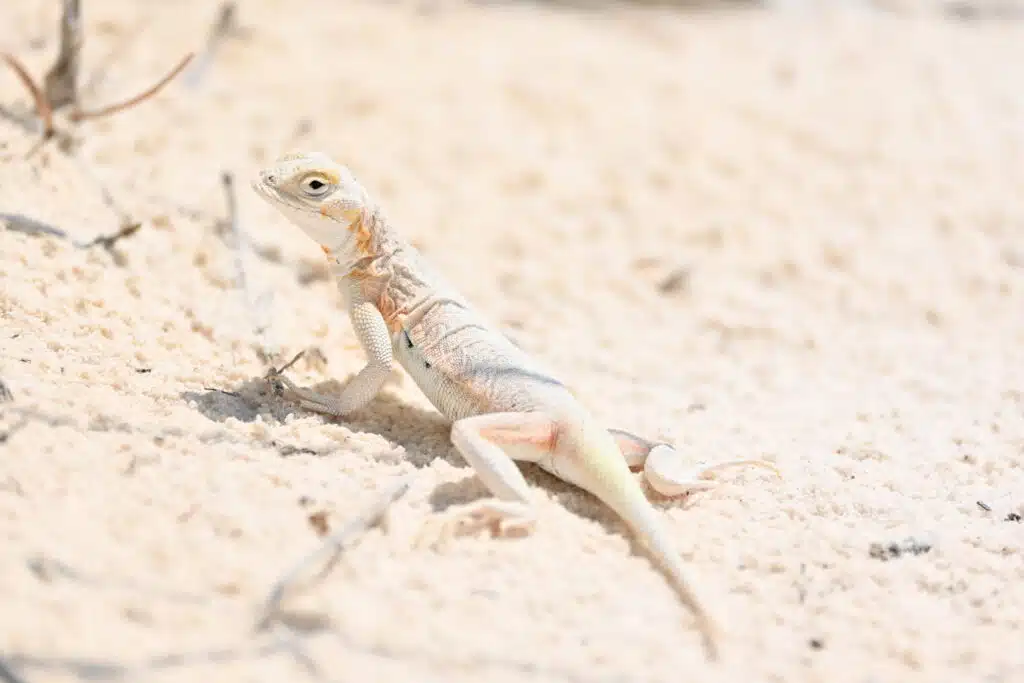
A species native to the Southwestern United States deserts and territories, Bleached Earless Lizards (Holbrookia maculata ruthveni) are mostly white.
White and gray nuances are mostly specific to the species which looks like white sand from above.
While it also lives outside sandy areas, this is a specimen highly common in areas with plenty of sand such as The White Sands National Park.
Also native to Mexico, The Bleached Earless Lizard grows to a length of up to 5 inches. Its mostly white appearance is believed to be as old as the species itself.
Some of the best times to spot this lizard is during the breeding period.
This is a time when males seek out females, putting out a breeding display. They can move about, fickle their tails, and balance their heads in various movements to attract potential mates.
A male lizard stretching out in the sun is actually a type of breeding mechanism when males try to attract females by displaying themselves out in the open.
You may also spot the lizard when it’s out for food. Some of the types of prey it chases include ants and bugs.
8. Little White Whiptail
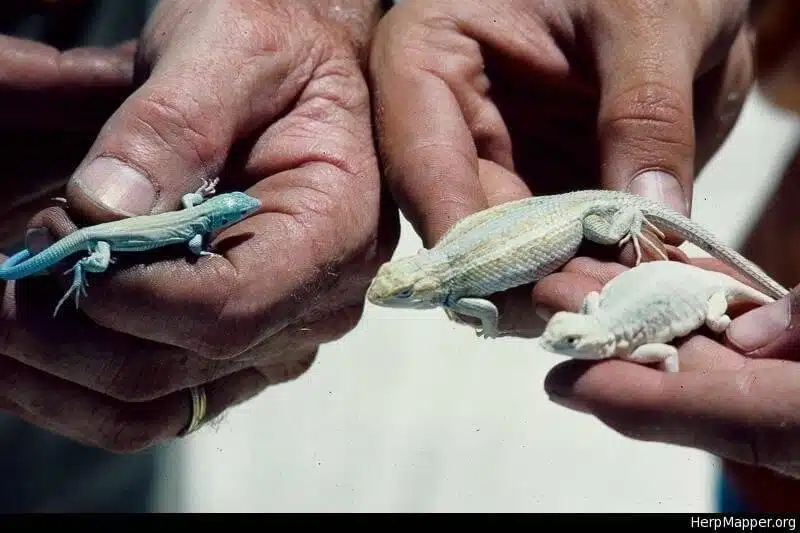
If Bleached Earless Lizards (Aspidoscelis inornatus gypsi) have a white gypsum color, the juvenile and female Little White Whiptails are mostly pure white.
They start to darken to a gypsum nuance as they grow, eventually developing various stripes along the dorsum.
Males of the species may also show additional blue heads and tails, together with darker stripes along the dorsum.
Much of the white color of Little White Whiptail lizards is impacted by the habitat of the species.
As Bleached Earless Lizards, Little White Whiptails are mostly found in deserts on white sands.
As a result, it takes on a bright appearance to defend itself through camouflage first.
The species is small, growing to a size between 3 and 5 inches.
While small, most of its body length is in fact represented by its extra-long tail.
This lizard often resorts to ambushing hunting techniques as it waits for insects and arachnids to pass by peaking out of its burrow.
9. Florida Sand Skink

Rarely spotted on the ground, Florida Sand Skinks (Plestiodon reynoldsi) live in the ground.
These almost pure white lizards have a distinct snake-like appearance as it seems they have no legs.
A species that reaches a size of only a few inches, this lizard can have a slight gray mid-dorsal nuance or a pink-red nuance as it ages.
Florida rosemary scrub is a habitat where this species takes on a slightly pink mid-dorsal nuance.
Only tiny front and rear legs are seen on these white underground skinks.
Even more, the skinks are a rare sight as they only live in sandy Central Florida terrains.
It’s here that they move underground and on the surface for various types of prey. They even eat termites, which potentially gives them a beneficial role in the ecosystem.
Due to the very small often unusable limbs of the species, the skink moves in wave patterns.
These wave patterns and its small legs often confuse the species with small white snakes in the region. Detecting the presence of the species even involves looking for clues similar to those left by snakes, such as wavy patterns on the ground.